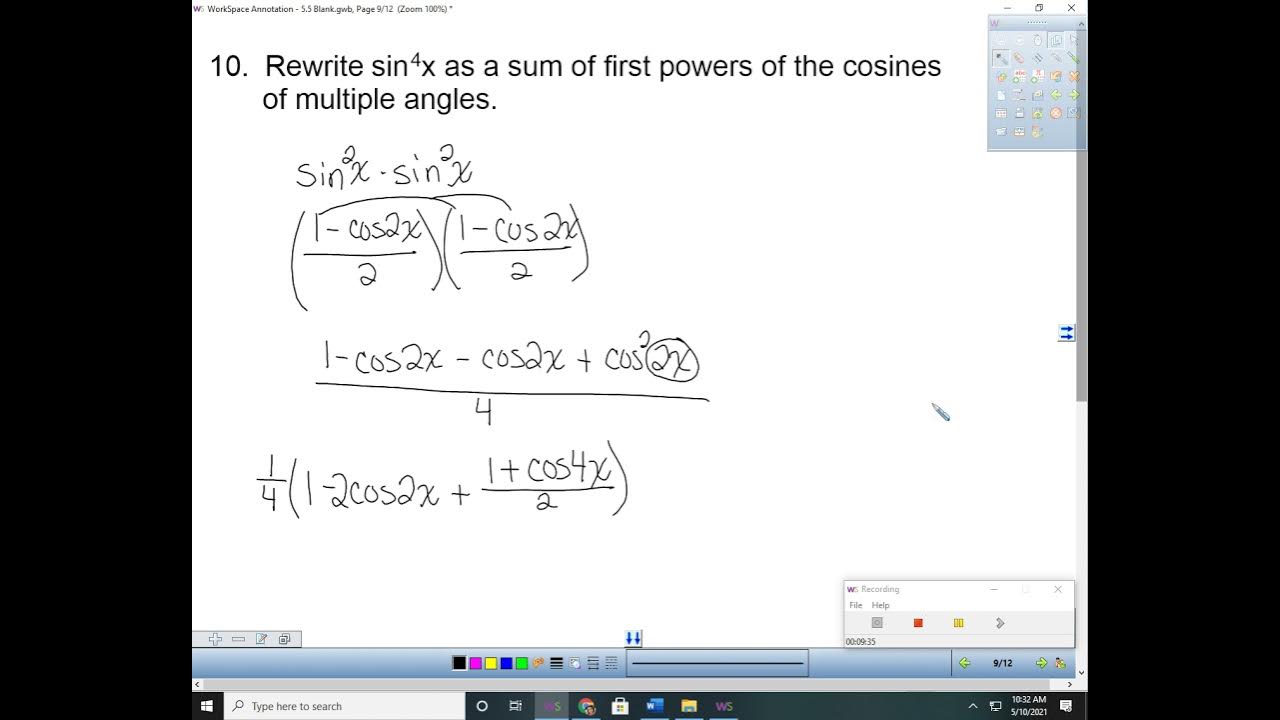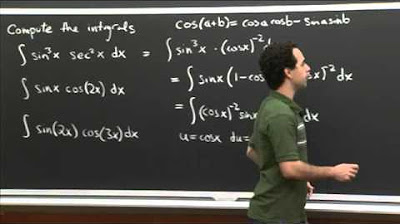Product To Sum Identities and Sum To Product Formulas - Trigonometry
TLDRThis educational video script focuses on simplifying trigonometric expressions using product-to-sum and sum-to-product formulas. It introduces four key formulas for each category and demonstrates their application through examples, such as simplifying sine 7x times sine 4x and sine 9x times cosine 3x. The script also covers sum-to-product formulas, illustrating their use with examples like sine 8x plus sine 3x and cosine 11x plus cosine 3x. Additionally, it provides a verification of the identity involving sine and cosine functions, proving that sine x plus sine 3x divided by cosine x plus cosine 3x equals tangent 2x. The emphasis is on understanding and applying these formulas to solve trigonometric problems efficiently.
Takeaways
- 📚 The video script introduces four product-to-sum trigonometric formulas that are essential for simplifying expressions.
- 🔍 The first formula presented is \( \sin(\alpha)\cos(\beta) = \frac{1}{2}(\cos(\alpha - \beta) - \cos(\alpha + \beta)) \).
- 📈 The second formula is \( \cos(\alpha)\cos(\beta) = \frac{1}{2}(\cos(\alpha - \beta) + \cos(\alpha + \beta)) \), with a positive sign for the sum of angles.
- 📉 The third formula is \( \sin(\alpha)\cos(\beta) = \frac{1}{2}(\sin(\alpha + \beta) + \sin(\alpha - \beta)) \), using sine instead of cosine.
- ➗ The fourth and final formula is \( \cos(\alpha)\sin(\beta) = \frac{1}{2}(\sin(\alpha + \beta) - \sin(\alpha - \beta)) \).
- 🧩 The script demonstrates how to apply these formulas to simplify specific trigonometric expressions, such as \( \sin(7x) \cdot \sin(4x) \).
- 📝 Another example given is simplifying \( \sin(9x) \cdot \cos(3x) \) using the product-to-sum formula.
- 🤔 The video also covers sum-to-product formulas, which are used to transform sums or differences of trigonometric functions into products.
- 📐 Examples of simplifying expressions using sum-to-product formulas include \( \sin(8x) + \sin(3x) \) and \( \cos(11x) + \cos(3x) \).
- 📉 The script provides a step-by-step guide on simplifying \( \sin(75^\circ) + \sin(15^\circ) \) using the sum-to-product formula.
- 🔑 A verification identity problem is tackled, showing that \( \frac{\sin(x) + \sin(3x)}{\cos(x) + \cos(3x)} \) is equal to \( \tan(2x) \).
Q & A
What are the four product-to-sum formulas mentioned in the script?
-The four product-to-sum formulas are: 1) sin(α)cos(β) = 1/2[cos(α-β) - cos(α+β)], 2) cos(α)cos(β) = 1/2[cos(α-β) + cos(α+β)], 3) sin(α)cos(β) = 1/2[sin(α+β) + sin(α-β)], and 4) cos(α)sin(β) = 1/2[sin(α+β) - sin(α-β)].
How can we simplify the expression sin(7x)sin(4x) using product-to-sum formulas?
-Using the formula sin(α)sin(β) = 1/2[cos(α-β) - cos(α+β)], and identifying α as 7x and β as 4x, the expression simplifies to 1/2[cos(7x-4x) - cos(7x+4x)] which is 1/2[cos(3x) - cos(11x)].
What is the simplified form of sin(9x)cos(3x) using product-to-sum identities?
-By using the formula sin(α)cos(β) = 1/2[sin(α+β) + sin(α-β)], and identifying α as 9x and β as 3x, the expression simplifies to 1/2[sin(9x+3x) + sin(9x-3x)] which is 1/2[sin(12x) + sin(6x)].
What are the sum-to-product formulas that are necessary to know according to the script?
-The sum-to-product formulas to know are: 1) sin(α) + sin(β) = 2sin[(α+β)/2]cos[(α-β)/2], 2) sin(α) - sin(β) = 2sin[(α-β)/2]cos[(α+β)/2], 3) cos(α) + cos(β) = 2cos[(α+β)/2]cos[(α-β)/2], and 4) cos(α) - cos(β) = -2sin[(α+β)/2]sin[(α-β)/2].
How do we simplify the expression sin(8x) + sin(3x) using sum-to-product formulas?
-Using the formula sin(α) + sin(β) = 2sin[(α+β)/2]cos[(α-β)/2], and identifying α as 8x and β as 3x, the expression simplifies to 2sin[(8x+3x)/2]cos[(8x-3x)/2] which is 2sin(11x/2)cos(5x/2).
What is the simplified form of cos(11x) + cos(3x) according to the sum-to-product identities?
-By using the formula cos(α) + cos(β) = 2cos[(α+β)/2]cos[(α-β)/2], and identifying α as 11x and β as 3x, the expression simplifies to 2cos[(11x+3x)/2]cos[(11x-3x)/2] which is 2cos(7x)cos(4x).
How do we simplify the expression sin(75°) + sin(15°) using sum-to-product formulas?
-Using the formula sin(α) + sin(β) = 2sin[(α+β)/2]cos[(α-β)/2], and identifying α as 75° and β as 15°, the expression simplifies to 2sin[(75°+15°)/2]cos[(75°-15°)/2] which is 2sin(45°)cos(30°), and the exact value is √6/2 after canceling out the common factors.
What identity are we trying to verify in the script's verifying identity problem?
-We are trying to verify the identity sin(x) + sin(3x) / [cos(x) + cos(3x)] = tan(2x).
How does the script suggest simplifying the top part of the fraction in the verifying identity problem?
-The script suggests using the sum-to-product formula for sine, which is sin(α) + sin(β) = 2sin[(α+β)/2]cos[(α-β)/2], with α as 3x and β as x, resulting in 2sin(2x)cos(x).
How does the script suggest simplifying the bottom part of the fraction in the verifying identity problem?
-The script suggests using the sum-to-product formula for cosine, which is cos(α) + cos(β) = 2cos[(α+β)/2]cos[(α-β)/2], with α as x and β as 3x, resulting in 2cos(2x)cos(x).
What is the final simplified form of the verifying identity problem in the script?
-After simplification, the fraction becomes tan(2x), which verifies the identity sin(x) + sin(3x) / [cos(x) + cos(3x)] = tan(2x).
Outlines
📚 Trigonometric Product to Sum Formulas
This paragraph introduces four trigonometric product to sum formulas, which are essential for simplifying expressions involving trigonometric functions. The formulas presented are: 1) \( \sin(\alpha)\cos(\beta) = \frac{1}{2}[\cos(\alpha - \beta) - \cos(\alpha + \beta)] \), 2) \( \cos(\alpha)\cos(\beta) = \frac{1}{2}[\cos(\alpha - \beta) + \cos(\alpha + \beta)] \), 3) \( \sin(\alpha)\cos(\beta) = \frac{1}{2}[\sin(\alpha + \beta) + \sin(\alpha - \beta)] \), and 4) \( \cos(\alpha)\sin(\beta) = \frac{1}{2}[\sin(\alpha + \beta) - \sin(\alpha - \beta)] \). The paragraph also demonstrates how to apply these formulas to simplify expressions such as \( \sin(7x)\sin(4x) \) and \( \sin(9x)\cos(3x) \), providing step-by-step solutions.
🔍 Sum to Product Trigonometric Identities
This section covers the sum to product trigonometric identities, which are used to transform the sum or difference of trigonometric functions into a product form. The identities include: 1) \( \sin(\alpha) + \sin(\beta) = 2\sin\left(\frac{\alpha + \beta}{2}\right)\cos\left(\frac{\alpha - \beta}{2}\right) \), 2) \( \sin(\alpha) - \sin(\beta) = 2\sin\left(\frac{\alpha - \beta}{2}\right)\cos\left(\frac{\alpha + \beta}{2}\right) \), 3) \( \cos(\alpha) + \cos(\beta) = 2\cos\left(\frac{\alpha + \beta}{2}\right)\cos\left(\frac{\alpha - \beta}{2}\right) \), and 4) \( \cos(\alpha) - \cos(\beta) = -2\sin\left(\frac{\alpha + \beta}{2}\right)\sin\left(\frac{\alpha - \beta}{2}\right) \). Examples provided include simplifying \( \sin(8x) + \sin(3x) \) and \( \cos(11x) + \cos(3x) \) using these identities.
📉 Verifying Trigonometric Identity with Sum to Product
The final paragraph focuses on verifying a specific trigonometric identity using the sum to product formulas. The identity to be proven is \( \frac{\sin(x) + \sin(3x)}{\cos(x) + \cos(3x)} = \tan(2x) \). The explanation begins by applying the sum to product identities to both the numerator and the denominator separately. The process simplifies the expression to \( \frac{\sin(2x)}{\cos(2x)} \), which is equivalent to \( \tan(2x) \), thus successfully verifying the identity. This paragraph emphasizes the importance of memorizing these formulas for efficient problem-solving in trigonometry.
Mindmap
Keywords
💡Product to Sum Formulas
💡Trigonometric Expressions
💡Sine Function
💡Cosine Function
💡Sum to Product Formulas
💡Angles
💡Simplification
💡Tangent Function
💡Verification of Identity
💡Trigonometric Identities
Highlights
Introduction to product-to-sum formulas in trigonometry.
First formula: sine alpha * cosine beta = 1/2 * (cosine (alpha - beta) - cosine (alpha + beta)).
Second formula: cosine alpha * cosine beta = 1/2 * (cosine (alpha - beta) + cosine (alpha + beta)).
Third formula: sine alpha * cosine beta = 1/2 * (sine (alpha + beta) + sine (alpha - beta)).
Fourth formula: cosine alpha * sine beta = 1/2 * (sine (alpha + beta) - sine (alpha - beta)).
Application of product-to-sum formulas to simplify trigonometric expressions.
Example: Simplifying sine 7x * sine 4x using product-to-sum formulas.
Result: sine 7x * sine 4x = 1/2 * (cosine 3x - cosine 11x).
Example: Simplifying sine 9x * cosine 3x using product-to-sum formulas.
Result: sine 9x * cosine 3x = 1/2 * (sine 12x + sine 6x).
Introduction to sum-to-product formulas.
First sum-to-product formula: sine alpha + sine beta = 2 * sine ((alpha + beta) / 2) * cosine ((alpha - beta) / 2).
Second sum-to-product formula: sine alpha - sine beta = 2 * sine ((alpha - beta) / 2) * cosine ((alpha + beta) / 2).
Third sum-to-product formula: cosine alpha + cosine beta = 2 * cosine ((alpha + beta) / 2) * cosine ((alpha - beta) / 2).
Fourth sum-to-product formula: cosine alpha - cosine beta = -2 * sine ((alpha + beta) / 2) * sine ((alpha - beta) / 2).
Example: Simplifying sine 8x + sine 3x using sum-to-product formulas.
Result: sine 8x + sine 3x = 2 * sine 11x * cosine 5x / 2.
Example: Simplifying cosine 11x + cosine 3x using sum-to-product formulas.
Result: cosine 11x + cosine 3x = 2 * cosine 14x * cosine 8x / 2.
Example: Simplifying sine 75 + sine 15 degrees using sum-to-product formulas.
Result: Exact value of sine 75 + sine 15 degrees using trigonometric values.
Verification of an identity: sine x + sine 3x / (cosine x + cosine 3x) = tangent 2x.
Explanation of how to use sum-to-product formulas to prove the identity.
Final verification of the identity using trigonometric identities.
Transcripts
Browse More Related Video

5.5 Multiple Angle and Product to Sum Formulas (Part 2)

Trig Integral Practice | MIT 18.01SC Single Variable Calculus, Fall 2010

Lec 3 | MIT 18.01 Single Variable Calculus, Fall 2007

Simplifying Trigonometric Expressions Using Power Reducing Formulas

Integral of sinx cosx

Ultimate trig identity problem study guide!
5.0 / 5 (0 votes)
Thanks for rating: